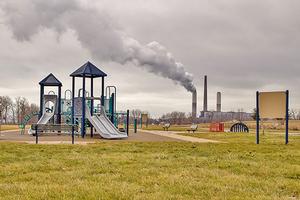Research
Evidence Shows Costly Superfund Cleanup Worth the Investment

New evidence finds prenatal exposure to hazardous waste contamination during pregnancy can significantly hurt a child’s development and performance in school. Living near a Superfund site with a toxic mix of pollutants can translate into greater rates of cognitive disabilities, lower test scores, and more frequent school suspensions among children when compared to younger siblings conceived after cleanups, according to research by AU School of Public Affairs (SPA) Assistant Professor Claudia Persico.
A Superfund site is one of nearly 1700 locations in the U.S. identified by the Environmental Protection Agency (EPA) as a candidate for cleanup because the land poses a risk to human health or the environment. These include manufacturing facilities, processing plants, landfills, and mining sites where hazardous waste was dumped or improperly managed. With locations in nearly every U.S. city––some sites have houses built directly on top of them––Superfund ubiquity allows researchers to observe the effects on residents, said Persico.
In her study, Persico analyzed the effect of prenatal exposure to environmental toxins on all Florida children born between 1994 and 2002 using matched birth and school records. Academic achievement and mental impairments were substantially worse for children developing near the Superfund sites than for other, later-born, siblings who were not near the pollution.
“The effects of Superfund site exposure on cognitive and behavioral outcomes are much larger than would be predicted by birth outcomes,” said Persico, who has been researching the issue for nearly six years. Her paper, published in the Journal of Labor Economics, is coauthored by David Figlio of Northwestern University and Jeffrey Roth of the University of Florida.
Among recent calls to cut EPA funding for the program, Persico’s research features a cost-benefit analysis that shows investing in Superfund cleanup matters. Indeed, Persico said, the Superfund program would pay for itself in 38 years through reduced special education costs alone. Cleanup also has the potential for far-reaching positive impacts on health, education, and job opportunity.
“It’s something that is not necessarily on people’s radar as being a hazard to children, but it does exist and poses a threat—in particular to pregnant women and their gestating babies,” said Persico, who was surprised by the magnitude of the findings showing the link between exposure and cognitive disabilities in children. “It’s pretty shocking and paints a negative picture of how pollution can harm developing children in the United States.”
Persico says she hopes policymakers take note of the research and realize the importance of cleanup efforts; support often cuts along party lines, with Republicans less inclined to fund the agency and its regulations.
“The program is a success story. The EPA is doing the hard work of actually fixing this problem,” Persico said. “The paper provides evidence about the cost effectiveness of these parts of the EPA budget. The Superfund program is expensive, but it has huge social benefits.”
